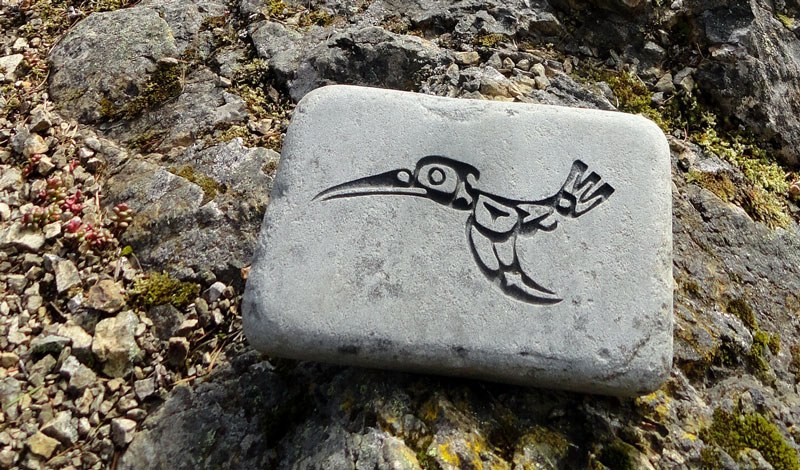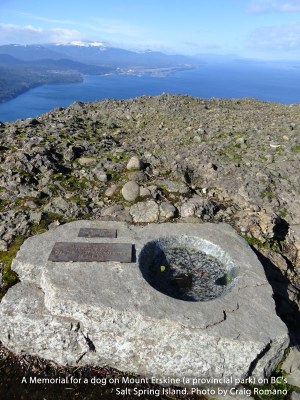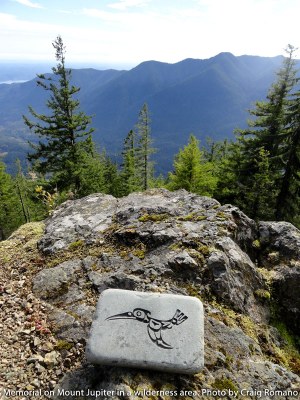
by Craig Romano, guidebook author
They’re all over Latin America. Along roadsides and in town squares; makeshift memorials honoring the lives of so many who departed this world prematurely. Usually placed on location of a terrible accident; these memorials allow us to reflect on the life taken from that very spot—and perhaps to lament the unfortunate situation leading up to it — alcohol, speed, negligence, distraction — the list goes on.
In heavily Catholic Latin America most of these memorials make reference to the Blessed Mother. Folks pray at these spots that the departed are now at peace in the Kingdom of Heaven. Some of the memorials are simple — some elaborate — some artistic — some derelict and strewn with litter. When I’ve walk the roads of South America or hiked the winding trails leading high into that continent’s hills and mountains I've come to accept these memorials as part of the landscape — part of the culture — part of the experience.
Back here in North America I am noticing with more frequency the proliferation of makeshift memorials (usually for victims of drunk drivers) along our roadways — and I am noticing more and more makeshift memorials along our trails in the backcountry. The trailside ones however are not as uniform in their purpose. I’ve encountered a few memorializing an untimely death at the spot due to a climbing accident, weather incident, or other unfortunate occurrence while out in the backcountry. But more and more I am stumbling upon memorials of folks who didn’t die at the spot, but want to be remembered there.

The urge for immortality is strong in most human beings and we want to somehow live on this earthly plain forever. For many of us, spiritual or not, the natural world is a sacred place. We may wish to have our ashes scatted upon our favorite trail — from atop our favorite mountain — along the shoreline of our favorite lake — or tossed into the surf at our favorite spot along the coast. And if we believe in an afterworld or nothing afterward at all — our souls have moved on — our earthly remains like our time on the planet ephemeral. Ashes to ashes, dust to dust, let a Douglas fir take root and come to life in what was once a being.
This need however to mark our passing with something concrete is quite different. It’s one thing to have a loved one toss your remains to the winds from atop Mount Rainier — or perhaps (although illegal) to have your body decompose in the wilderness as Ed Abbey requested. "I want my body to help fertilize the growth of a cactus or cliff rose or sagebrush or tree,” he wrote. However, even Mr. Abbey has an inscribed (by some of his friends) rock somewhere in the desert backcountry. But to construct something material to leave alongside the trail or deep in the backcountry memorializing your passage doesn’t nourish the circle of life nor honor the purpose of life — that all things must pass. As more and more of these memorials appear — some quite elaborate and I dare say obtrusive (nobody will ever know that your ashes lie along the trail) — I’m afraid it just may be compromising the nature of the backcountry — distracting from the living’s relationship with the natural environment — and in the case of Wilderness areas, is a direct violation of one of our strongest pieces of environmental legislation.
I’m going to die someday too, so perhaps I should just lighten up and live with these memorials, right? And I too have a strong need to be memorialized and remembered after my passage. I contribute to conservation causes as part of my legacy. I have a young son that I will pass the torch on, hoping he will continue to enlighten others on the need to protect our environment. And if I’m fortunate, perhaps someday I can donate enough money to have a trail or park named after me! But leaving a permanent object marking my short time on the planet for all to see whether they want to or not; and regardless if they knew me or not (and few do and will as time moves on) can be viewed as just plain obtrusive. And image this scenario as it multiplies. One memorial here or there — no big deal, right? Soon one becomes two-then three-then ten — then on and on nearly every trail. Walk a road in rural South America if you want to see where this can go — but then again maybe that is okay — or is it?

I admit that I've been fascinated with several memorials that I have stumbled upon in the backcountry. One in particular — a stone plaque with a Coast Salish art style raven (the creator) etched into it sitting on a knoll high on Mount Jupiter in the Brothers Wilderness was absolutely beautiful. And in my eyes it harmonized well with its natural environment. At almost all of the memorials I have passed in the woods, I have paused briefly — reflected upon who the person was or could be and what happened — and then moved on. Admittedly none of these memorials compromised my wilderness experience. Others I know feel differently. And I have never removed one. My Catholic roots and respect for the dead would never allow me to sleep in peace again if I did. But I know of others that have and will remove these memorials as they do with unauthorized cairns, flagging, and illegal campfire rings. To these folks, these memorials no matter their intention are a pure violation of the Wilderness Act and have no place in these earthly natural environments.
I know I’ll see more of them — giving me plenty more time to reflect on more lives lost and if they should be remembered by something solid in the backcountry.
How do you feel about these memorials in the backcountry? Are they even an issue with all of the more pressing problems out there like climate change, refugee crises, and continual loss of habitat — issues that have far graver results for the natural world than a scattering of monuments honoring the deceased. Do you want to leave something concrete behind at your favorite piece of wilderness heaven?
Craig Romano is an avid hiker, runner, paddler, and cyclist, and has written about these passions for over two dozen publications, including Seattle Met, Backpacker, Northwest Runner, AMC Outdoors, Northwest Travel, and Outdoors NW. He is the content provider for Hikeoftheweek.com, author of ten books and co-author of four others including the recently released Day Hiking the San Juans and Gulf Islands and Day Hiking Mount St Helens.
Add a comment
Log in to add comments.I think that memorials in the back country are an inappropriate intrusion on the wilderness experience. It is also likely that the dead person would have preferred not to be memorialized in such a way. It serves no public purpose on public land.
I have come across a few of these memorials left by caring people and I often pause to consider the unknowable life of the dead. Nonetheless, I do consider them to be undesirable visual pollution that should be removed if at all possible. In the future I will do exactly that. Please, remove these memorials and restore the natural.
If you want to memorialize your friend, loved one, family member, please consider donating a bench or actual money to a conservation organization. Or organize a clean-up visit with your friends. Make a real contribution in your loved ones name. Don't leave a visual scar on the very land your loved one loved as it was originally.
 Craig Romano
Craig Romano